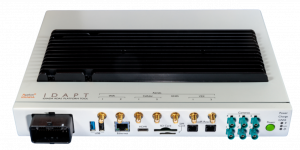Multi-Car Collision Avoidance (MuCCA) Project: World’s first demonstration of collective collision avoidance between real cars.
Our Applus+ IDIADA team in the UK recently completed the Multi-Car Collision Avoidance (MuCCA) Project, a high-profile connected and automated vehicle (CAV) project. The aim was to develop and demonstrate an advanced safety concept in which several autonomous cars use vehicle-to-vehicle (V2V) communications to cooperate in real time to avoid a collision. With this technology, a group of automated vehicles can help each other to avoid accidents in a way that would be impossible for individual human drivers.
Applus+ IDIADA was the lead partner in a consortium of six organizations, and the project was supported by the Government of the United Kingdom for a duration of two and a half years. In addition to the overall project coordination, our team was responsible for the complete development and integration of the electronics and software that made it possible for cars to drive autonomously and communicate to achieve cooperation.
Each MuCCA car, equipped with cameras and sensors, obtained real-time information about the local environment and then shared it with the rest of the vehicles, contributing to a common “world view”. This was possible thanks to the V2V communications, which instantly enabled this wireless data exchange. This shared knowledge already surpasses what an individual driver would perceive alone, and therefore gave the vehicles an advantage in evaluating the situation and deciding how to avoid a collision.
In the event of a dangerous situation, each MuCCA unit took control of the vehicle and started sharing its planned trajectories. This, combined with the capability of each car to adapt its plans in a fraction of a second after considering the ones from the other vehicles, triggered coordinated maneuvers that would be difficult to achieve even for the most experienced human drivers.
For those cases in which a non-connected human-driven vehicle could be involved in a risky situation, a neural network was implemented to predict where human-driven vehicles were likely to drive in near-accident scenarios. This feature meant to cover scenarios that could be happening in the near future, when autonomous vehicles share the same space as traditional vehicles without driving aid.

As part of this project, we developed our own electronic control unit called IDAPT, combining all the features needed in one single device: a high-performance computer with satellite positioning, vehicle/sensor interfaces, and V2V communications. We designed both hardware and software for this unit, which has then served on several other projects as a single-box solution for many CAV application problems. IDAPT is now available to solve further engineering challenges.
After validating the concept in a bench-test simulation setup, the system was tested in a controlled environment using foam targets replicating broken-down vehicles as stationary objects in the freeway. The selected test scenario involved two MuCCA vehicles driving side by side along adjacent lanes and encountering obstacles in their path to challenge the algorithms and force a coordinated reaction of the autonomous system.
The result was that the cars swerved to make space for each other as they avoided the different obstacles. Like a shoal of fish or a flock of birds, they became individuals working together as a group without a specific leader. This movement was not decided in advance; it was up to the simple but powerful cooperation algorithms to solve the situation, using the V2V messaging to share intended and preferred trajectories. At some points, we were surprised that the cars found a different-than-expected solution to the situation, depending on the speeds and positions they started with.
We believe this was the first demonstration in the world of multiple full-sized vehicles performing autonomous, cooperative collision avoidance. It showed how Applus+ IDIADA can solve new problems in the connected and automated vehicle field, an experience that can be carried forward to client projects.